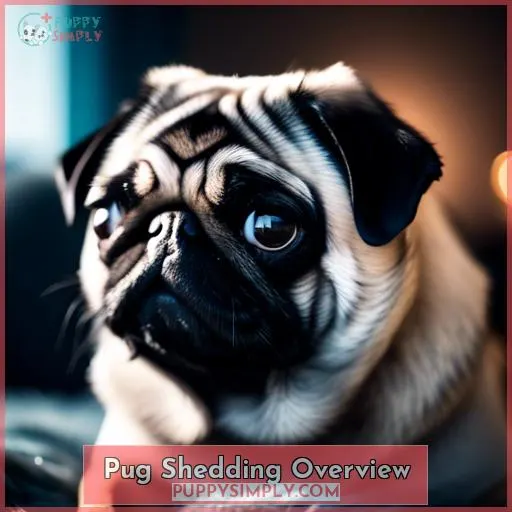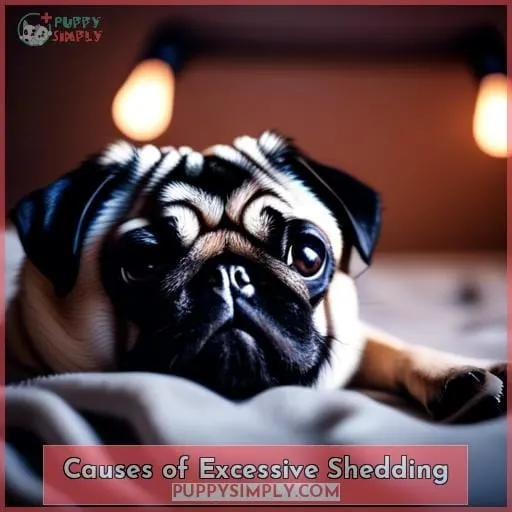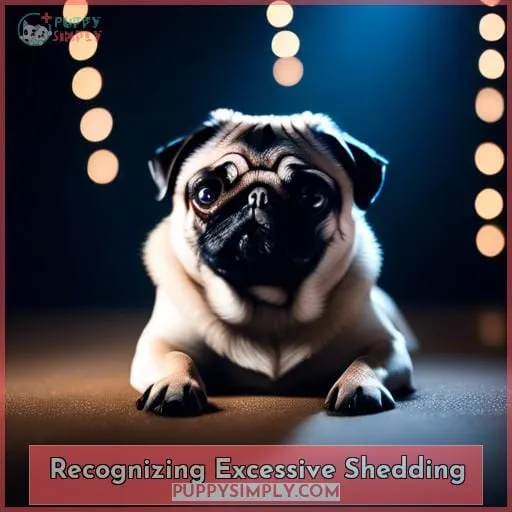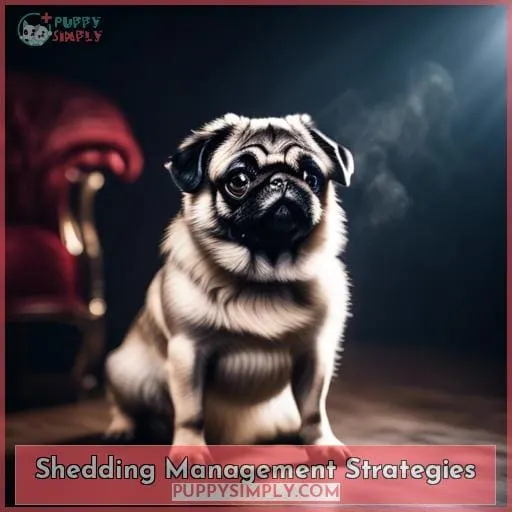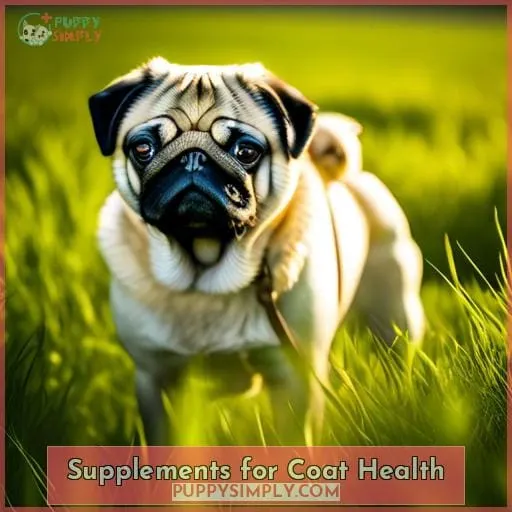This site is supported by our readers. We may earn a commission, at no cost to you, if you purchase through links.
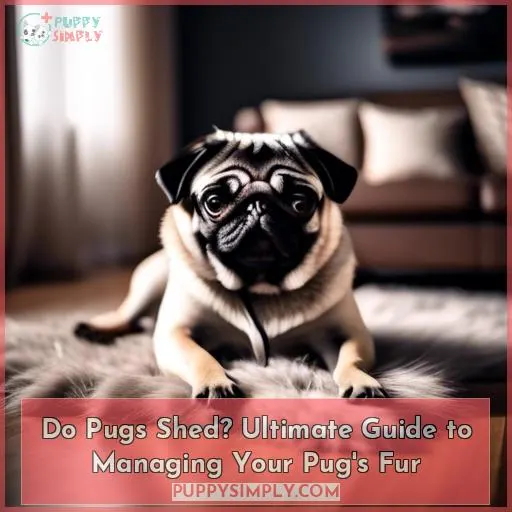 Discover the truth about your pug’s shedding habits and learn how to manage their fur effectively.
Discover the truth about your pug’s shedding habits and learn how to manage their fur effectively.
But don’t worry, with the right knowledge and tools, you can keep their shedding under control. This guide offers insights into why pugs shed, how to recognize excessive shedding, and practical strategies for maintaining a healthy coat.
Embrace the joy of pug ownership while keeping your home fur-free.
Yes, pugs do shed. They are considered a heavy shedding breed, with the amount of shedding varying between individuals and coat types.
Table Of Contents
- Key Takeaways
- Pug Shedding Overview
- Causes of Excessive Shedding
- Recognizing Excessive Shedding
- Shedding Management Strategies
- Supplements for Coat Health
- Home Cleaning Solutions
- Frequently Asked Questions (FAQs)
- How does the texture of a Pug’s coat affect the amount of shedding?
- Can the climate or weather conditions influence a Pug’s shedding patterns?
- Are there any specific life stages when a Pug’s shedding might temporarily increase or decrease?
- How do different grooming techniques impact the health of a Pug’s coat and its shedding?
- Can a Pug’s emotional state or stress levels affect its shedding, and if so, how?
- Conclusion
Key Takeaways
- Pugs are a heavy shedding breed with a double coat that sheds year-round, especially during seasonal transitions, making regular grooming and brushing essential for managing shedding.
- Factors such as coat color, age, health, and diet can influence the amount a pug sheds, with fawn-colored pugs generally shedding more than black ones due to their double coat.
- Excessive shedding in pugs can be a sign of underlying health issues such as allergies, skin conditions, or hormonal imbalances, and should be addressed by a veterinarian.
- Managing pug shedding involves regular grooming with appropriate tools, using deshedding shampoos, maintaining a nutrient-rich diet with omega supplements, and keeping the home clean with vacuuming and lint removal tools.
Pug Shedding Overview
Pugs are known for their charming personalities and distinctive looks, but they also come with a notable grooming requirement: shedding. If you’re bringing a pug into your home, be prepared for their double coat to shed throughout the year, with peaks during seasonal changes.
Understanding the characteristics of their coat, including color variations and shedding patterns, is crucial for managing this aspect of pug care effectively.
Double Coat Characteristics
You’ll notice your Pug’s double coat consists of a dense undercoat and a longer outer layer, which contributes to their year-round shedding.
- Employ double coat grooming techniques regularly.
- Use double coat brushing to minimize loose fur.
- Invest in a double coat vacuuming tool for your home.
- Enhance double coat nutrition to support healthy fur.
Seasonal Shedding Patterns
Pugs, known for their charming personalities and distinctive looks, experience seasonal shedding patterns that can significantly affect the amount of fur they lose throughout the year. Shedding in Pugs intensifies during spring and autumn, aligning with major temperature changes that prompt them to shed their winter or summer coats in preparation for the upcoming season.
This natural cycle is crucial for maintaining their comfort and adapting to environmental changes.
| Season | Shedding Intensity |
|---|---|
| Spring | High |
| Summer | Moderate |
| Autumn | High |
| Winter | Low |
| Year-Round | Moderate to High |
To manage seasonal shedding effectively, it’s essential to implement regular grooming routines, including more frequent brushing during peak shedding periods, to help remove loose fur and minimize its spread around the home.
Additionally, maintaining a healthy diet and considering supplements rich in omega fatty acids can support skin and coat health, potentially reducing excessive shedding.
Color and Coat Types
When considering color and coat types in pugs, black pugs typically have single coats and shed less compared to their double-coated counterparts.
Genetics play a crucial role in determining whether a pug will have a single or double coat, influencing shedding patterns.
While shedding in puppies and during heat can increase, understanding these coat types offers effective pug shedding solutions.
Causes of Excessive Shedding
Pugs are known for their charming personalities and distinctive looks, but they also come with a unique set of grooming challenges, particularly when it comes to shedding. If you’ve noticed your Pug shedding more than usual, it’s important to understand the underlying causes.
Allergies and skin conditions, along with hormonal influences, can significantly impact the amount of fur your Pug loses. Managing these factors effectively can help control excessive shedding and keep your furry friend comfortable.
Allergies and Skin Conditions
Skin conditions and allergies are significant contributors to your Pug’s excessive shedding, often leading to increased discomfort and hair loss.
Flea infestations and environmental factors can exacerbate these issues.
Incorporating omega fatty acids, like those found in fish oil, into their diet can work wonders.
Regular treatment and a good pug vacuum for cleanup can make managing your furry friend’s shedding seem like magic.
Hormonal Influences
While managing allergies and skin conditions is crucial, you should also be aware that hormonal changes can significantly influence your Pug’s shedding patterns.
- Pregnancy and heat cycles can escalate shedding, leaving more fur around your home.
- Neutered males may experience less hormonal fluctuation, potentially stabilizing shedding.
- Regardless of single or double coats, pugs shed year-round, with some months heavier than others.
Recognizing Excessive Shedding
As a pug owner, it’s crucial to recognize signs of excessive shedding that may indicate underlying health issues.
Keep an eye out for bald spots and monitor your pug for increased itchiness or changes in skin health.
These symptoms can be early warnings that your pug needs extra care or a visit to the vet.
Identifying Bald Spots
Bald spots on your pug can be a concerning sign of excessive shedding and may indicate underlying health issues beyond normal shedding patterns.
Regularly inspecting your pug’s coat for any unusual hair loss, such as bald patches, can help you catch these issues early.
If you notice bald spots, it’s essential to consider various factors, including allergies, hormonal imbalances, or skin infections, as potential causes.
Addressing these concerns promptly with your veterinarian can prevent further hair loss and ensure your pug remains healthy and comfortable.
Monitoring Itchiness and Skin Health
You can easily monitor your pug’s itchiness and skin health to recognize signs of excessive shedding.
- Persistent scratching, indicating skin irritation
- Flaky skin or dandruff, requiring control measures
- Changes in fur color, suggesting coat discoloration
- Seasonal reactions that may point to allergies
These signs help determine if your pug’s shedding is normal or if a visit to the vet is needed.
Shedding Management Strategies
Managing your Pug’s shedding is crucial for keeping both your pet and your home comfortable. You’ll need to establish a routine that includes regular grooming and brushing, as well as selecting the right bathing products.
A proper diet enriched with essential nutrients can also play a significant role in maintaining your Pug’s coat health.
Grooming and Brushing Techniques
Effective grooming and brushing techniques are essential in managing your pug’s shedding effectively.
| Deshedding Tools | Brush Selection |
|---|---|
| FURminator | Boar Bristle Brush |
| Grooming Gloves | Slicker Brush |
| Professional Grooming | Pin Brush |
| Grooming Frequency | Brushing Technique |
| ———————— | ———————– |
| At least 3 times a week | Gentle, regular strokes |
| More during shedding | Reach undercoat |
Bathing and Shampoo Recommendations
Following the discussion on the importance of regular grooming for your pug, it’s crucial to choose the right bathing products to manage shedding effectively.
Opt for deshedding shampoos that support coat conditioning and skin moisturizing.
Your shampoo selection should complement monthly bathing routines, ensuring it nurtures the skin and fur, reducing excess shedding while keeping your pug’s coat healthy and vibrant.
Dietary Considerations
A nutrient-rich diet is essential for managing your Pug’s shedding, as it supports healthy skin and fur.
- Include foods that mitigate food allergies, reducing skin irritation and unwanted hair loss.
- Choose an appropriate diet that promotes a healthy hair growth cycle and maintains coat thickness.
- Integrate omega supplements to nourish the skin and fortify the fur.
- Avoid ingredients known to exacerbate shedding and poor coat health.
Supplements for Coat Health
When it comes to managing your pug’s shedding, incorporating supplements into their diet can be a game-changer.
Omega fatty acids, in particular, play a crucial role in promoting healthy skin and a lustrous coat, which can significantly reduce shedding.
By selecting high-quality supplements rich in these essential nutrients, you’re taking a proactive step towards minimizing excess fur and ensuring your pug’s coat remains in top condition.
Benefits of Omega Fatty Acids
Optimal health for your pug’s coat can be achieved through the incorporation of omega fatty acids. These essential nutrients, found in supplements like salmon oil, play a crucial role in maintaining skin and fur vitality.
Bolstering skin health, they can lead to a lustrous, fuller coat with less shedding.
Regular inclusion in your pug’s diet supports overall well-being and a vibrant appearance.
Selecting Quality Supplements
After exploring the benefits of omega fatty acids for your pug’s coat health, it’s crucial you know how to pick the right supplements.
Emphasize the importance of research, focusing on brands known for safety and effectiveness.
Check labels for ingredients to avoid, like artificial additives.
Consider cost, but don’t compromise on quality.
Prioritize products with positive reviews for peace of mind.
Home Cleaning Solutions
As a pug owner, you’re well aware that shedding is part of the package. To keep your home clean, investing in a high-quality vacuum cleaner and lint removal tools is essential.
Regular use of these items, along with the right grooming tools and brushes, can significantly reduce the impact of shedding on your living space.
Vacuuming and Lint Removal Tools
While many supplements can significantly reduce your pug’s shedding, you’ll still need to regularly use a vacuum and lint rollers to manage the hair in your home.
Invest in a powerful pet hair vacuum for thorough carpet cleaning and use furniture covers to protect sofas and chairs.
Sticky rollers are handy for quick pet hair removal, and air purifiers can keep dander at bay.
Grooming Tools and Brushes
Incorporating grooming gloves and brushes into your cleaning routine can significantly reduce your pug’s shedding around the home.
- Deshedding tools: Swiftly remove loose fur, minimizing the hair you’ll find on your furniture and floors.
- Grooming mitts: Offer a soothing massage, enhancing bonding while capturing shed hairs.
- Slicker brush: Gently untangles, ensuring a smooth, healthy coat.
- Undercoat rake: Targets the dense underlayer, significantly reducing shedding when used regularly.
Frequently Asked Questions (FAQs)
How does the texture of a Pug’s coat affect the amount of shedding?
The texture of a Pug’s coat influences shedding. Double-coated Pugs shed more due to dense, rapid hair growth, while single-coated Pugs shed less.
Coat type impacts shedding frequency and intensity, requiring tailored grooming and maintenance routines.
Can the climate or weather conditions influence a Pug’s shedding patterns?
Yes, climate and weather conditions can influence a Pug’s shedding patterns.
Seasonal changes, particularly in temperature and sunlight hours, trigger periods of increased shedding as Pugs adapt their coats for different weather.
Are there any specific life stages when a Pug’s shedding might temporarily increase or decrease?
Yes, Pugs experience specific life stages when their shedding might temporarily increase or decrease. Pug puppies tend to shed more as they transition out of their puppy coat, starting around three months old.
As Pugs reach adulthood, around 1 to 5 years, shedding increases. Female Pugs may shed more during heat cycles due to hormonal changes.
Seasonal changes also affect shedding, with increased shedding in spring and summer as they shed their winter coats.
How do different grooming techniques impact the health of a Pug’s coat and its shedding?
Regular grooming significantly benefits your pug’s coat health and shedding management. Brushing a few times weekly with tools like the FURminator or grooming gloves removes loose hair, reducing shedding around your home.
Bathing with deshedding shampoo monthly can further minimize shedding by cleaning and nourishing the skin and coat.
Supplements rich in omega-3 fatty acids, like salmon oil, promote a healthy, shiny coat and can decrease shedding. Always consult your vet before adding supplements to ensure they’re suitable for your pug.
Can a Pug’s emotional state or stress levels affect its shedding, and if so, how?
Yes, a Pug’s emotional state or stress levels can indeed affect its shedding. Like a storm brewing on the horizon, stress can cause a flurry of fur to fly, signaling your Pug’s discomfort.
When they’re anxious or stressed, their body responds by releasing epinephrine (adrenaline), which can lead to increased shedding. This phenomenon, known as stress shedding, can occur in various situations that make your Pug feel uneasy, such as visits to the vet, loud noises, or unfamiliar environments.
Conclusion
Wondering how to keep your home free of pug fur? With the right grooming, dietary choices, and cleaning practices, managing your pug’s shedding is a breeze.
Regular brushing, quality shampoos, and omega-rich supplements will ensure your pug’s coat stays healthy and shedding is minimized.
Don’t forget to equip your home with effective cleaning tools to tackle any stray hairs.
Embrace the joy of pug ownership and enjoy a fur-free environment.

